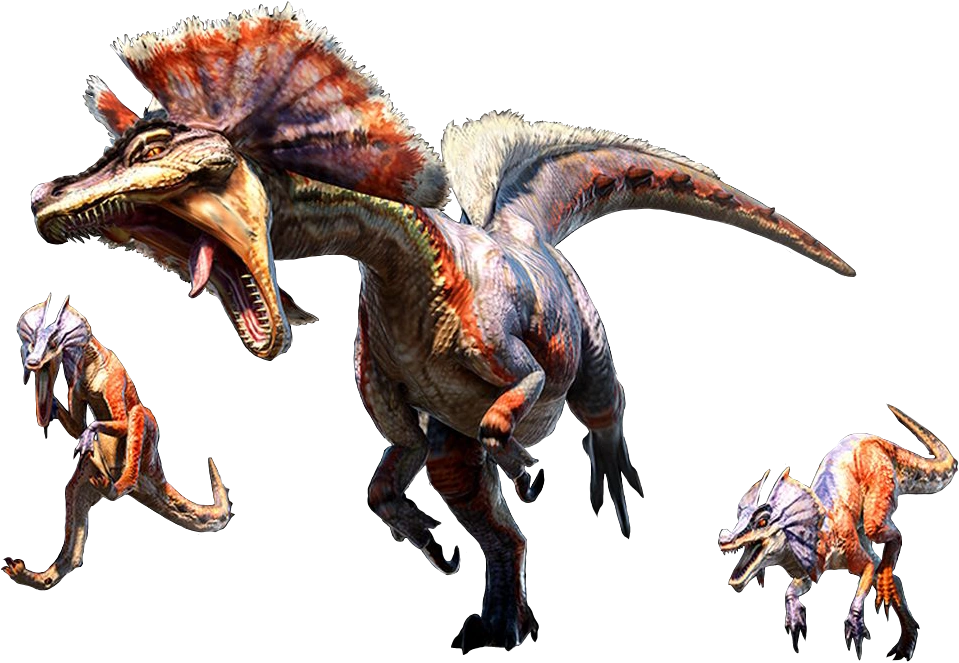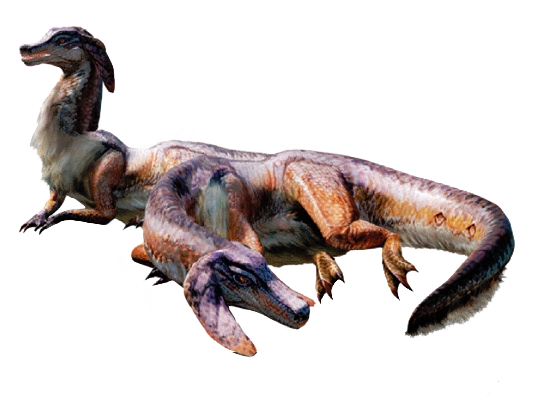 Social pack-hunting Bird Wyverns easily distinguished by the pair of ear-like frills they sport on the sides of their head. Their pack hierarchy is divided into three castes: the small immature male Jaggi, the medium-sized female Jaggia and the large mature male Great Jaggi.
Social pack-hunting Bird Wyverns easily distinguished by the pair of ear-like frills they sport on the sides of their head. Their pack hierarchy is divided into three castes: the small immature male Jaggi, the medium-sized female Jaggia and the large mature male Great Jaggi. Jaggi are primarily orange in colour with lavender scales present on their head, frills, parts of their forearms and as a stripe running down their backs. Their roles are to patrol the outskirts of the territory, inform the pack about intruders, hunt small prey to feed the pack and assist the Great Jaggi while hunting larger prey. They have short blunt spines protruding from the sides of their tails which can be used to attack prey or defend themselves when threatened.
Jaggi are primarily orange in colour with lavender scales present on their head, frills, parts of their forearms and as a stripe running down their backs. Their roles are to patrol the outskirts of the territory, inform the pack about intruders, hunt small prey to feed the pack and assist the Great Jaggi while hunting larger prey. They have short blunt spines protruding from the sides of their tails which can be used to attack prey or defend themselves when threatened.Jaggia have more lavender scales completely covering their backs and tail, with somewhat fewer orange scales which cover their sides and legs. Unlike the males, their frills are more subdued and hang limply from their heads. Instead of spines, their tails are adorned with fur running down their undersides. This downy fur is present on their bellies as well and is most likely used to incubate their young. Jaggia are responsible for guarding the nest and raising whelps. [To act as effective nest guardians, they are bulkier than Jaggi and even the females of the closely related Wroggi and Baggi, as they do not produce toxins or sleep-inducing compounds and thus have to rely solely on their increased muscle mass and strength. They also lay larger eggs than Baggi and Wroggi which allow more developed whelps to be hatched, shortening the amount of time needed for them to mature into Jaggi and Jaggia.]
Great Jaggi are mostly lavender in colour, only having a single orange stripe running down each side of their bodies and another tangerine stripe on the edges of their frills. Besides that, they have a white mane on their necks and a ridge of white fur running from their backs to their tail, which retains the blunt spines present in juvenile males. As the leader of the pack, Great Jaggi have the most prominent frills. *If their frills are destroyed, they lose all their dignity as a leader and a male.* Each pack is only led by one Great Jaggi at a time, so as Jaggi mature they are chased away to look for another pack to usurp. They have large hooked claws on their forelimbs, [though since they are not used in hunting prey, it is speculated that they use them to fight each other.] Multiple Great Jaggi may fight each other for the control of a pack, and many have been seen with wounds and scars on their bodies. Being the most powerful member of the pack, they lead Jaggi in hunting large herbivores such as Aptonoth using complex vocal commands and protect the pack from major threats such as other wyverns.
Typically, Jaggi are found in numerous locales from deserts to grasslands to forests. However, they are absent from dense jungles, volcanic areas and frigid arctic habitats. On their own, Jaggi hunt small prey such as fish and Kelbi, but under the leadership of a Great Jaggi they can bring down larger herbivores such as Aptonoth and Rhenoplos. [For large prey that they cannot bring down quickly, they utilize a persistence hunting technique where they chase prey over fairly long distances in order to wear them down before cornering the exhausted prey and killing it. This technique may not be as effective in rainforests with thick vegetation, which explains their absence in those areas.] *At a kill, Great Jaggi always eat first, Jaggia eat second and Jaggi eat last.* Some theorize that this is the reason for the disparity in size between the three castes, [or alternatively the behavior may result from the size disparity itself.] Carrion scavenged from the kills of larger monsters also constitute a major part of their diet.
Being relatively low in the food chain, Jaggi have to be wary of other carnivores as their flesh is relatively high in nutritional value. Despite that, their speed and agility acts as a deterrent to larger predators.
No comments:
Post a Comment